#uss chesapeake
Explore tagged Tumblr posts
Text

The Capture of USS Chesapeake, 1st June 1813 by John Steven Dews
55 notes
·
View notes
Text
As the battle between USS Chesapeake and HMS Shannon raged in June, 1813, Chesapeake was blown into her opponent after a devasting carronade salvo, becoming temporarily hooked on a fluke of the British ship's anchor as the ships collided.

The Tars of Old England Triumphant, 1813 print (Old Print Shop, NYC).
In this close action, the Shannon's officers and crew boarded the enemy ship—and those in the fighting tops ran across yard arms, including midshipmen.
As Chesapeake’s sails began to fill the ship lurched forward. As her side scraped down the Shannon’s forward end her foreyard fouled Shannon’s briefly. Seeing a momentary opportunity, Midshipman John Smith stationed in the foremast fighting top, ran out over the yard followed by five of his topmen and onto Chesapeake’s foreyard. Fighting their way up into the enemy foretop they forced the Americans there to flee down the weather-side shrouds.
Seven men in Chesapeake’s mizzen top armed with muskets and a small howitzer were still causing great execution amongst Shannon’s boarders. Seeing this, Midshipman Philip Cosnahan across in Shannon’s main top began to pick them off one by one using a succession of loaded muskets passed down to him through the lubber’s hole.
— Martin Bibbings, "The Battle," in Broke of the Shannon and the War of 1812, edited by Tim Voelcker.

A model diorama of an early 19th century fighting top by Flagship Models.
#midshipman monday#war of 1812#hms shannon#uss chesapeake#age of sail#naval history#naval battle#age of fighting sail#military history#broke of the shannon and the war of 1812#fighting top#royal navy#us navy
62 notes
·
View notes
Text
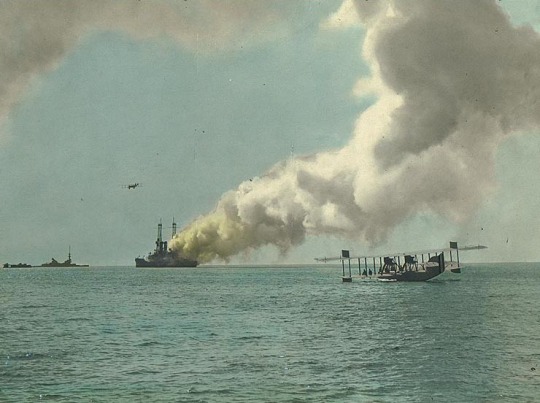
"Army bombing tests on former USS ALABAMA.
Ex-USS ALABAMA (BB-8) showing the effect of a phosphorus bomb, while serving as a target for U.S. Army bombers in Chesapeake Bay. An Army Martin twin-engine bomber is flying overhead. Also visible, in the foreground, is a Navy F5L seaplane. Wrecks in the distance are the old battleships San Marcos (furthest to the left) and Indiana, both of which had been used as targets.
Date: September 27, 1921
U.S. Naval History and Heritage Command: NH 263-KN (color)
#USS Alabama (BB-8)#USS Alabama#Illinois Class#Predreadnought#USS San Marcos (1892)#USS San Marcos#USS Texas (1892)#USS Texas#Second Rate Battleship#Battleship#Warship#Ship#United States Navy#U.S. Navy#US Navy#USN#Navy#Chesapeake Bay#Virginia#East Coast#Felixstowe F5L#F5L#Martin NBS-1#bomber#flying boat#September#1921#interwar period#colorized photo#my post
17 notes
·
View notes
Text
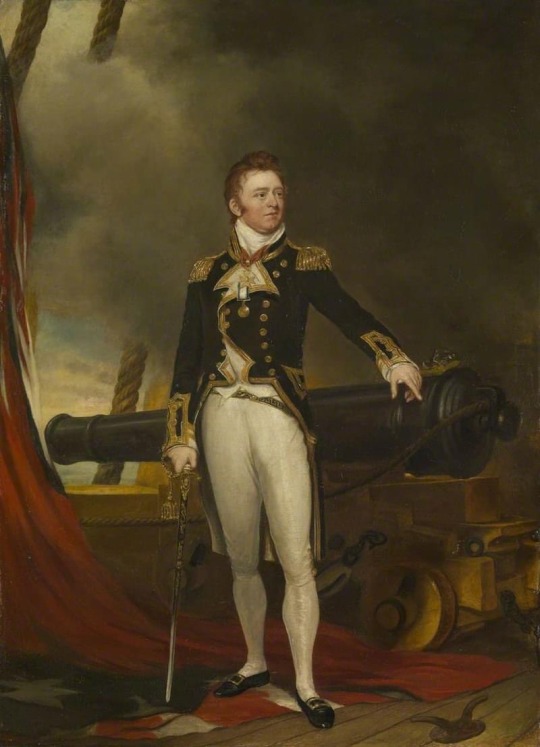
Captain Sir Philip Bowes Vere Broke, by Samuel Lane. During his lifetime, he was often referred to as "Broke of the Shannon", a reference to his notable command of HMS Shannon in the War of 1812. His most famous military achievement was defeating and capturing the American frigate, USS Chesapeake.
187 notes
·
View notes
Text

The U.S. Navy escort carrier USS Block Island (CVE-21) off the Chesapeake Bay on 15 October 1943
23 notes
·
View notes
Text

USS Chesapeake, 38, looking particularly handsome under a pyramid of canvas. Painting by F. Muller (early 20th century).
Launched in Portsmouth, Virginia, in 1799, she was one of the original six frigates of the United States Navy authorized in the Naval Act of 1794. She saw service in the Quasi-War with France and the First Barbary War before being involved in two famous run-ins with the Royal Navy. First, in 1807, HMS Leopard, 50, ran down, fired on, and boarded the Chesapeake to impress Royal Navy deserters, despite the US and Great Britain being at peace. Then, in 1813, now at war, the Chesapeake famously sailed out of Boston harbor to fight a single-ship action with the blockading HMS Shannon, 38, and was captured, breaking the Royal Navy’s streak of defeats in single-ship actions with the Americans. She then had a brief career as HMS Chesapeake before being decommissioned in 1819.
Also has a special place in my heart as a Marylander 🌊🦀🌊
28 notes
·
View notes
Photo
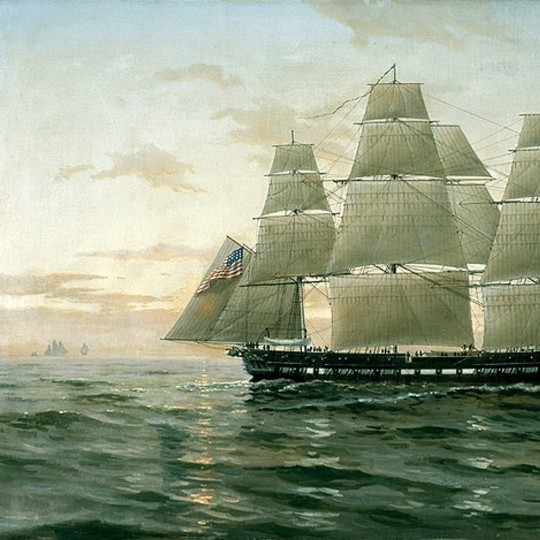
Chesapeake-Leopard Affair
The Chesapeake-Leopard affair was an incident that took place off the coast of Norfolk, Virginia, on 22 June 1807 when the British warship HMS Leopard fired on and boarded an American frigate USS Chesapeake while searching for deserters from the Royal Navy. The incident was one of the events that led to the War of 1812.
Background
In 1807, as the United States was still struggling to find its footing as an independent nation, the Napoleonic Wars were raging in Europe. Napoleon Bonaparte, having crowned himself Emperor of the French three years before, found himself opposed by a series of ever-shifting coalitions of European nations bankrolled by Great Britain. On land, Napoleon's armies had proved dominant; with such great victories as the Battle of Austerlitz (2 December 1805) and the Battle of Friedland (14 June 1807), he had conquered Central Europe and was now exerting influence throughout most of the continent. Britain, meanwhile, had smashed French naval power at the Battle of Trafalgar (21 October 1805) and was afterwards the undisputed master of the waves. This dichotomy left the neutral United States in a precarious position: to deal with one empire meant to upset the other. President Thomas Jefferson, nervously keeping tabs on the developments in Europe, voiced the concerns of many of his countrymen when he wrote: "What an awful spectacle does the world exhibit in this instant, one man bestriding the continent of Europe like a Colossus, and another roaming unbridled on the ocean" (Wood, 622).
But even as the war created anxiety in America, so, too, did it open the door of opportunity. American merchants were quick to capitalize on the gap in international trade caused by the fighting; with France and Spain no longer able to send merchant ships to their colonies in the West Indies, these colonies reluctantly opened their ports to American ships instead. The Americans would then re-export these Caribbean goods to European markets, making a fortune in the process. In 1807, the combined value of American imports and exports reached $243 million, turning the United States into the largest neutral carrier of goods in the world. When Britain complained that the United States' middleman trade strategy violated their so-called Rule of 1756 – which prevented nations from trading in times of war with ports that had been closed to them in times of peace – the Americans circumvented the rule by importing the Caribbean goods to the United States before re-exporting them to Europe, technically turning them into neutral cargo in the process.
American shipping would become threatened, however, as the Franco-British rivalry reached its stalemate. Unable to directly attack the British Isles due to the power of the Royal Navy, Napoleon decided to instead force Britain's submission by paralyzing its economy. In November 1806, he issued the Berlin Decree, the first block in his Continental System, in which he issued a continent-wide embargo on British trade. Any ship carrying British goods was liable for seizure, including those belonging to neutral countries. Britain retaliated with several orders-in-council, which placed a blockade on all ports that complied with Napoleon's embargo, stipulating that all nations who wished to trade at these ports had to first stop in England to pay transit duties. This, of course, left the American merchants in a difficult situation, as they could no longer trade at any European port without running afoul of either the French or the British. Before long, the warring empires were each seizing neutral American ships; between 1803 and 1812, France seized 558 American vessels, while the British captured 917.
Continue reading...
19 notes
·
View notes
Text
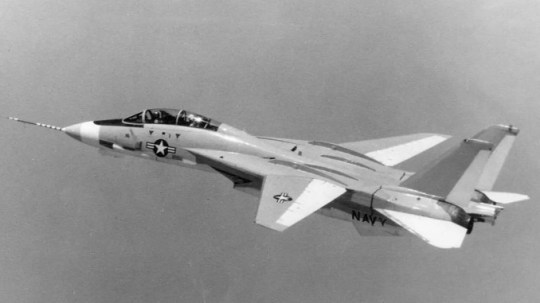
On This Day In 1970 The Grumman F-14 Tomcat Made Its First Flight
December 21, 2019 Military Aviation
the first Full Scale Development (FSD) Grumman F-14A Tomcat (BuNo 157980) during its first flight in 1970. (Image credit: Grumman)
It’s the anniversary of Turkey’s first flight.
On Dec. 21, 1970, the first Full Scale Development (FSD) Grumman F-14A Tomcat (BuNo 157980) took off for its maiden flight from Grumman’s flight test centre at Calverton, on Long Island.
The poor weather conditions forced the two test pilots flying the first “Turkey” (as the aircraft would be later nicknamed), Grumman chief test pilot Robert K. Smyth and project test pilot William Miller, to cut the maiden flight, carried out a month ahead of the contracted data, short. However, in spite of the short duration of the flight (consisting in a few visual patterns with wing swept forward), the F-14 had taken to the air for the first time: the first of many flights in the U.S. until the last one conducted in 2006.
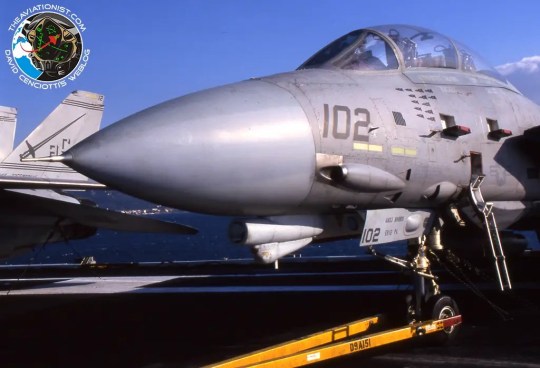
An F-14 with bomb markings earned during Operation Desert Fox in 1999, aboard USS Enterprise. The aircraft’s role evolved during the years and the F-14 also carried out the bomber mission in a variant also referred to as “Bombcat”. (Image credit: Author).
The F-14 BuNo 157980 took off for the second test flight on Dec. 30 with the two test pilots swapping their seats: Miller sat in the front cockpit and Smyth in the back. The second flight is quite famous in the story of the Tomcat, as the aircraft crashed due to hydraulic failure: a mishap that was caught on camera by a chase plane.
Ezoic
Here’s how we described that second sortie in a previous article we published here at The Aviationist:
It was during this flight that a chase plane noted that the Tomcat was leaving a trail of smoke: shortly thereafter the F-14 experienced a primary hydraulic system failure forcing Miller to head immediately back to base.
While they were preparing to land, the secondary hydraulic system also failed, due to the use of the emergency nitrogen bottle to lower the landing gear: once it failed, the crew tried to rely on the Combat Survival System which had to supply the power to the rudders and tailerons only.
However this last limited control system showed signs of failing as well, the pilot lost control all over the aircraft and the crew was forced to eject.
The breakdown was caused by a fatigue failure of both titanium main hydraulic lines due to a coincidence of pump resonance and a loose connector: ironically, the F-14’s hydraulic system was fixed by changing from titanium to stainless steel hydraulic lines only.
As you can see from footage (around 03:20 min), the crew ejected only few meters above the trees but, luckily, they suffered only minor injuries.
Sadly, Miller died on 30 June 1972 when its Tomcat crashed into Chesapeake Bay during preparation for an air display with the tenth FSD F-14 (BuNo 157989), while Smyth passed away this year.
Both Smyth and Miller contributed in bringing the last in a long tradition of Grumman Cats to life.
The F-14 is still flying in Iran.
About David Cenciotti
David Cenciotti is a journalist based in Rome, Italy. He is the Founder and Editor of “The Aviationist”, one of the world’s most famous and read military aviation blogs. Since 1996, he has written for major worldwide magazines, including Air Forces Monthly, Combat Aircraft, and many others, covering aviation, defense, war, industry, intelligence, crime and cyberwar. He has reported from the U.S., Europe, Australia and Syria, and flown several combat planes with different air forces. He is a former 2nd Lt. of the Italian Air Force, a private pilot and a graduate in Computer Engineering. He has written five books and contributed to many more ones.
@theaviationist via X
56 notes
·
View notes
Text
Hampton Roads Naval Museum VA






Let’s talk specifically about the USS Chesapeake!

#1812 commodores#war of 1812#preble’s boys#age of sail#us navy#James Lawrence#museums#virginia#virginia is for lovers#rosey travels
6 notes
·
View notes
Note
Apropos your recent remarks on Regency men, the great outdoors, and military service, do you think the picture of Washington, D.C. burning is strictly necessary for this variety? Or only statistically probable? I'm worried it would clash with my collection of pastoral landscape paintings, but also wouldn't want to deprive the Regency man of necessary enrichment. Should I be looking at a different type of 19th century man more compatible with my art collection?
Hello! I am jumping ahead in the order of asks to respond to this question about managing expectations for Regency men.
The portrait with Washington, D.C. in flames is not strictly necessary for perhaps the great majority of men in this time period; but you must allow for the iconic nature of Sir George Cockburn's c. 1817 portrait in his rear-admiral's pattern 1812-25 undress coat with Hessian boots and spurs, and the burning Capitol buildings in Washington behind him. The ultimate statement in military might and Napoleonic-era civilian fashion, melded together in an expression of brilliant masculinity!

It's pronounced COH-burn, for your information.
Despite all this, some would baulk at the underlying violence of such a portrait. If your 19th century man has a penchant for this sort of display, he may be content with a comparable marine tableau—perhaps HMS Shannon capturing USS Chesapeake!
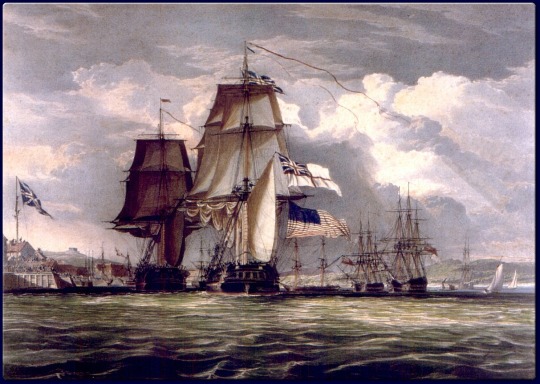
Surely, this majestic view of Halifax Harbour will compliment any pastoral landscape.
24 notes
·
View notes
Text

1st June 1813: The battle between USS Chesapeake and HMS Shannon, by Jenny Morgan (1942-)
196 notes
·
View notes
Text

A decade of Republican hostility had taken a heavy toll on the navy, but seventeen ships still survived in 1812. Seven were frigates. The Constitution, President, and United States were rated at 44 guns; the Constellation, Chesapeake, and Congress at 36 guns; and the Essex at 32 guns. [...] The frigates were the heart of the navy. Inspired by Philadelphia shipwright Joshua Humphreys, the three heavy frigates—or “44s” as they were called—were bigger and sturdier than other frigates. They carried heavier guns (24-pounders rather than 18-pounders) and their thick hulls were better able to withstand enemy broadsides. In fact, they were “superfrigates,” capable of outfighting and outsailing other ships in their class and of outrunning anything larger.
— Donald R. Hickey, The War of 1812: A Forgotten Conflict
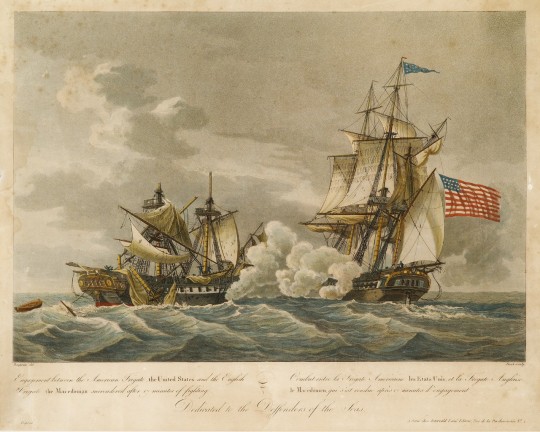
Engagement between the American Frigate United States and the English Frigate Macedonian Surrendered after 17 Minutes of Fighting, 1815 lithographic print (US Naval History and Heritage Command)
#War of 1812 Wednesday#war of 1812#age of sail#naval history#frigates#us navy#military history#uss united states#naval art#the sea#love the precise mention of '17 minutes' in the title of the print#someone is still mad about uss chesapeake#age of fighting sail#us history
51 notes
·
View notes
Text

View of after gun turret and superstructure of USS SAN MARCOS (ex-USS TEXAS (1892)), just after she had been used as a target by USS NEW HAMPSHIRE (BB-25) in Chesapeake Bay.
Dates: March 1911
U.S. Naval History and Heritage Command: NH 73109
#USS San Marcos (1892)#USS San Marcos#ex-USS Texas#USS Texas (1892)#USS Texas#Second Rate Battleship#Battleship#Warship#Ship#Target Ship#Chesapeake Bay#Virginia#East Coast#United States Navy#U.S. Navy#US Navy#USN#Navy#March#1911#my post
28 notes
·
View notes
Text

Grumman F6F-3 Hellcat (VF-50) launching from the USS Bataan off Chesapeake Bay, January 1944.
22 notes
·
View notes
Text

USS MISSISSIPPI (CGN-40) On trials in Chesapeake Bay, 27 June 1978. Note crewmen at flight stations, with firemen ready, and Mk26 missile launcher and 5"/54 MK45 gun trained abeam. USN Image
13 notes
·
View notes
Text

A U.S. Navy Grumman F6F Hellcat prepares to take off from the escort carrier USS Charger (CVE-30) 8 May 1944, during training operations in Chesapeake Bay.
23 notes
·
View notes